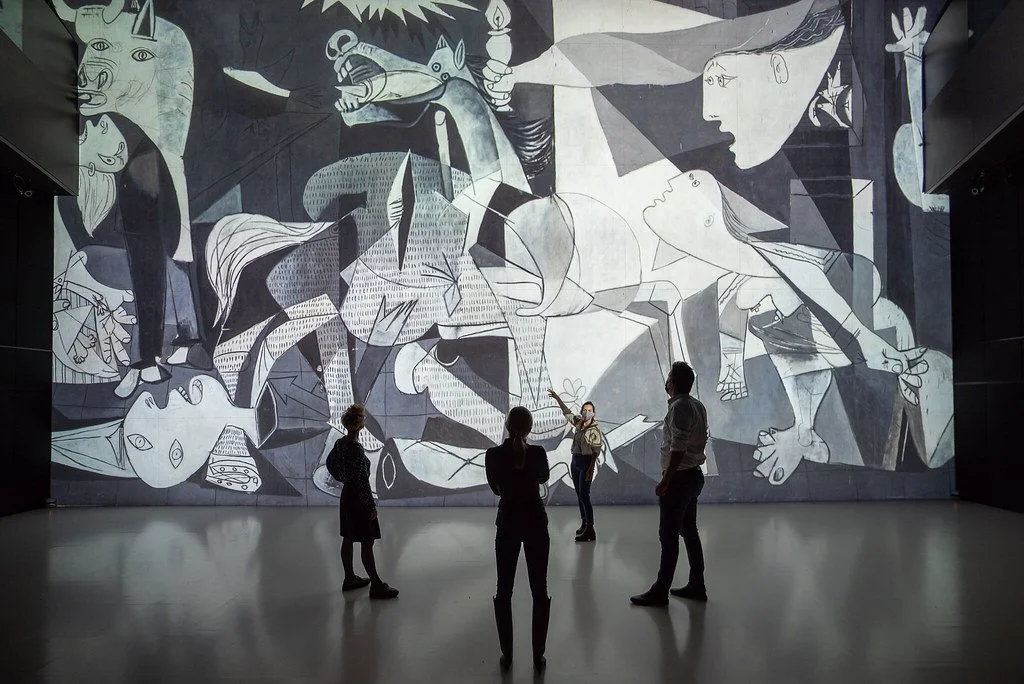As an iconic anti-war symbol, “Guernica” evolves once more amid the Israel-Palestinian conflict
Guernica on display at the Museo Nacional Centro de Arte Reina Sofía. CC BY-NC-ND 2.0.
First exhibited at the 1937 Exposition Universelle, Pablo Picasso’s “Guernica” is a mural with deeply rooted political history that extends beyond the reasoning for its inception. Commissioned by the Spanish Republican government as a work of propaganda against fascism, “Guernica” was inspired by the bombing of civilians Guernica, Spain by forces allied to Hitler. Since then, the piece has become the emblem for various anti war movements, and most recently has been adopted by those in support of Palestine.
After being exhibited at the fair in 1937, in 1939 “Guernica” made its way across various U.S. cities, and eventually was housed in the Museum of Modern Art in Manhattan for 41 years until it returned to Spain in 1981. The mural was a formidable inspiration for many American artists, such as Jackson Pollock.
Moreover, the Art Workers Coalition, a group of artists, museum staff, critics and writers, adopted “Guernica” as part of their movement against American involvement in the Vietnam War. Throughout the 60s and 70s, the group created posters featuring the mural to use alongside various slogans like, “Stop the war in Vietnam now!”
In the decades since the Vietnam War, “Guernica” has been at the root of various different protests, and was even on one occasion vandalized with the words, “kill lies all.” Most recently, the piece has been integrated into the movement for solidarity with Gaza.
This past December, a protest held at the Pasialeku Market Place in Guernica was organized by the Guernica-Palestine Citizens’ Initiative. Thousands assembled at the market and when aerially viewed, created a mosaic of the Palestinian Flag and a section of “Guernica.” The location of the protest was intentional, designed to draw similarities between the current conflict in Palestine and the civilian bombing in 1937 that served as the initial catalyst for the piece.
Though not directly related to the painting, Guernica is also a non profit literary magazine dedicated to art and global politics. The magazine features a plethora of Palestinian writers, as well as pieces on addressing the nuances of this conflict.
Recently, however, the outlet is facing backlash for releasing an article by Joanna Chen in its March issue, entitled “From the Edges of a Broken World.” The article’s publication resulted in mass resignation of the magazine’s editors. In particular, people had issues with the following: “A neighbor told me she was trying to calm her children, who were frightened by the sound of warplanes flying over the house day and night. ‘I tell them these are good booms.’ She grimaced, and I understood the subtext, that the Israeli army was bombing Gaza,” which could be interpreted as approving of the bombardment.
Some regarded the piece as “white colonialism masquerading as goodness,” in reflection of Chen’s British origins. However, in light of the controversy, many readers seeking out the essay found no problems with its content. April Zhu, a senior editor, wrote that she believed the article did not align with an “earnest, urgent, and risky resistance to U.S. imperialism and all others,” which she felt Guernica, the magazine, embodied and was founded on.
Although Guernica’s editor-in-chief, Jina Moore, resigned on April 5 amid the backlash, she maintains that the article aligns with what the publication is known for. In her statement of resignation, she said, “I saw the piece as an example of the difficult work that Guernica is known for: capturing, with complexity and nuance, how such violence is normalized, and how a violent state extracts complicity from its citizens.” Ultimately, her decision to resign reflects her support for the article, despite the magazine maintaining its decision to retract the piece. Aligned with the history of the painting, Guernica as a magazine shows that voices can diverge, even with the goal of peace at their roots.
Nicola DeGregorio
Nicola is studying English Literature at George Washington University, where she also reports for the student newspaper, The Hatchet. Nicola's passion for literature and writing has sparked an interest in exploring the broader context surrounding written texts. Researching and writing for Catalyst Planet allows her to investigate nuanced issues that intersect with her interests in art history, culinary practices, and cultural traditions.


